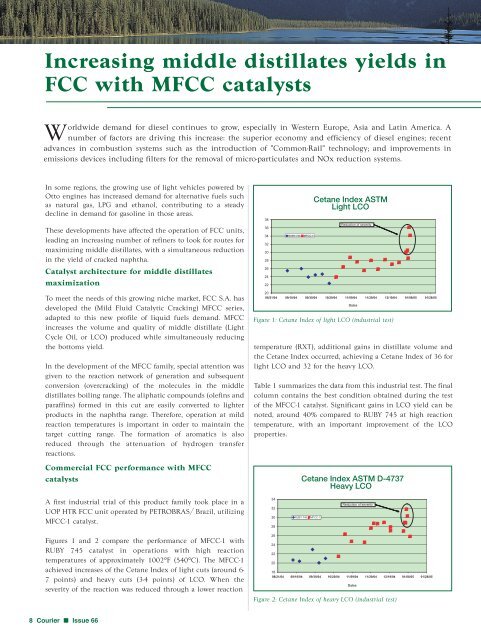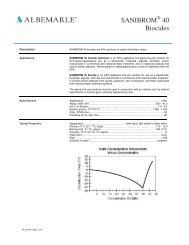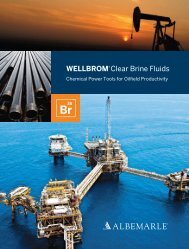Emissions in Remission - Albemarle Corporation
Emissions in Remission - Albemarle Corporation
Emissions in Remission - Albemarle Corporation
You also want an ePaper? Increase the reach of your titles
YUMPU automatically turns print PDFs into web optimized ePapers that Google loves.
Increas<strong>in</strong>g middle distillates yields <strong>in</strong><br />
FCC with MFCC catalysts<br />
Worldwide demand for diesel cont<strong>in</strong>ues to grow, especially <strong>in</strong> Western Europe, Asia and Lat<strong>in</strong> America. A<br />
number of factors are driv<strong>in</strong>g this <strong>in</strong>crease: the superior economy and efficiency of diesel eng<strong>in</strong>es; recent<br />
advances <strong>in</strong> combustion systems such as the <strong>in</strong>troduction of “Common-Rail” technology; and improvements <strong>in</strong><br />
emissions devices <strong>in</strong>clud<strong>in</strong>g filters for the removal of micro-particulates and NOx reduction systems.<br />
In some regions, the grow<strong>in</strong>g use of light vehicles powered by<br />
Otto eng<strong>in</strong>es has <strong>in</strong>creased demand for alternative fuels such<br />
as natural gas, LPG and ethanol, contribut<strong>in</strong>g to a steady<br />
decl<strong>in</strong>e <strong>in</strong> demand for gasol<strong>in</strong>e <strong>in</strong> those areas.<br />
These developments have affected the operation of FCC units,<br />
lead<strong>in</strong>g an <strong>in</strong>creas<strong>in</strong>g number of ref<strong>in</strong>ers to look for routes for<br />
maximiz<strong>in</strong>g middle distillates, with a simultaneous reduction<br />
<strong>in</strong> the yield of cracked naphtha.<br />
Catalyst architecture for middle distillates<br />
maximization<br />
To meet the needs of this grow<strong>in</strong>g niche market, FCC S.A. has<br />
developed the (Mild Fluid Catalytic Crack<strong>in</strong>g) MFCC series,<br />
adapted to this new profile of liquid fuels demand. MFCC<br />
<strong>in</strong>creases the volume and quality of middle distillate (Light<br />
Cycle Oil, or LCO) produced while simultaneously reduc<strong>in</strong>g<br />
the bottoms yield.<br />
In the development of the MFCC family, special attention was<br />
given to the reaction network of generation and subsequent<br />
conversion (overcrack<strong>in</strong>g) of the molecules <strong>in</strong> the middle<br />
distillates boil<strong>in</strong>g range. The aliphatic compounds (olef<strong>in</strong>s and<br />
paraff<strong>in</strong>s) formed <strong>in</strong> this cut are easily converted to lighter<br />
products <strong>in</strong> the naphtha range. Therefore, operation at mild<br />
reaction temperatures is important <strong>in</strong> order to ma<strong>in</strong>ta<strong>in</strong> the<br />
target cutt<strong>in</strong>g range. The formation of aromatics is also<br />
reduced through the attenuation of hydrogen transfer<br />
reactions.<br />
Commercial FCC performance with MFCC<br />
catalysts<br />
A first <strong>in</strong>dustrial trial of this product family took place <strong>in</strong> a<br />
UOP HTR FCC unit operated by PETROBRAS/ Brazil, utiliz<strong>in</strong>g<br />
MFCC-1 catalyst.<br />
Figures 1 and 2 compare the performance of MFCC-1 with<br />
RUBY 745 catalyst <strong>in</strong> operations with high reaction<br />
temperatures of approximately 1002°F (540°C). The MFCC-1<br />
achieved <strong>in</strong>creases of the Cetane Index of light cuts (around 6-<br />
7 po<strong>in</strong>ts) and heavy cuts (3-4 po<strong>in</strong>ts) of LCO. When the<br />
severity of the reaction was reduced through a lower reaction<br />
8 Courier ■ Issue 66<br />
38<br />
36<br />
34<br />
32<br />
30<br />
28<br />
26<br />
24<br />
22<br />
Figure 1: Cetane Index of light LCO (<strong>in</strong>dustrial test)<br />
temperature (RXT), additional ga<strong>in</strong>s <strong>in</strong> distillate volume and<br />
the Cetane Index occurred, achiev<strong>in</strong>g a Cetane Index of 36 for<br />
light LCO and 32 for the heavy LCO.<br />
Table 1 summarizes the data from this <strong>in</strong>dustrial test. The f<strong>in</strong>al<br />
column conta<strong>in</strong>s the best condition obta<strong>in</strong>ed dur<strong>in</strong>g the test<br />
of the MFCC-1 catalyst. Significant ga<strong>in</strong>s <strong>in</strong> LCO yield can be<br />
noted, around 40% compared to RUBY 745 at high reaction<br />
temperature, with an important improvement of the LCO<br />
properties.<br />
34<br />
32<br />
30<br />
28<br />
26<br />
24<br />
22<br />
20<br />
RUBY-745 MFCC-1<br />
Cetane Index ASTM D-4737<br />
Heavy LCO<br />
RUBY-745 MFCC-1<br />
Cetane Index ASTM<br />
Light LCO<br />
Reduction of severity<br />
20<br />
08/21/04 09/10/04 09/30/04 10/20/04 11/09/04 11/29/04 12/19/04 01/08/05 01/28/05<br />
Dates<br />
Reduction of severity<br />
18<br />
08/21/04 09/10/04 09/30/04 10/20/04 11/09/04 11/29/04 12/19/04 01/08/05 01/28/05<br />
Dates<br />
Figure 2: Cetane Index of heavy LCO (<strong>in</strong>dustrial test)





